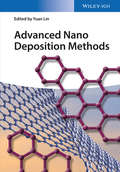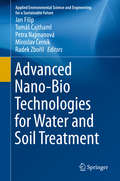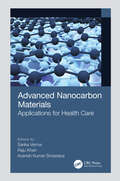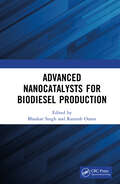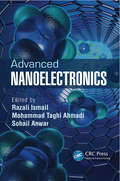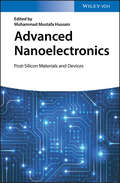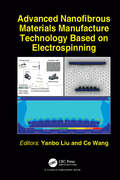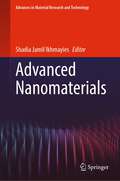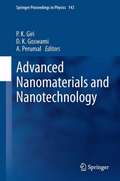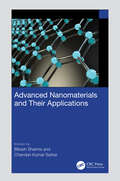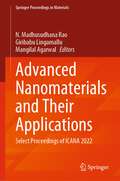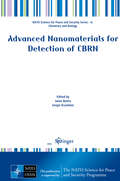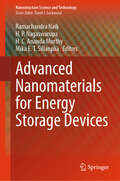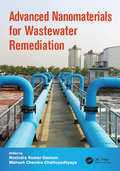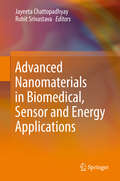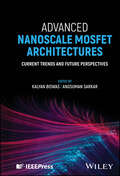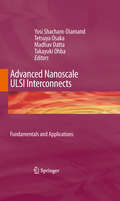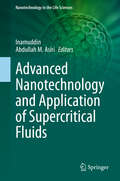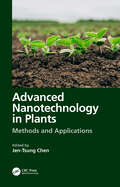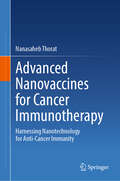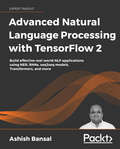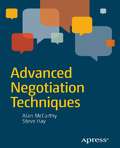- Table View
- List View
Advanced Nano Deposition Methods
by Yuan LinThis concise reference summarizes the latest results in nano-structured thin films, the first to discuss both deposition methods and electronic applications in detail. Following an introduction to this rapidly developing field, the authors present a variety of organic and inorganic materials along with new deposition techniques, and conclude with an overview of applications and considerations for their technology deployment.
Advanced Nano-Bio Technologies for Water and Soil Treatment (Applied Environmental Science and Engineering for a Sustainable Future)
by Jan Filip Tomáš Cajthaml Petra Najmanová Miroslav Černík Radek ZbořilWe are proposing this comprehensive volume aimed at bridging and bonding of the theory and practical experiences for the elimination of a broad range of pollutants from various types of water and soil utilizing innovative nanotechnologies, biotechnologies and their possible combinations. Nowadays, a broad range of contaminants are emerging from the industry (and also representing old ecological burdens). Accidents and improper wastewater treatment requires a fast, efficient and cost-effective approach. Therefore, several innovative technologies of water and soil treatments have been invented and suggested in a number of published papers. Out of these, some nanotechnologies and biotechnologies (and possibly also their mutual combinations) turned out to be promising for practical utilization – i.e., based on both extensive laboratory testing and pilot-scale verification. With respect to the diverse character of targeted pollutants, the key technologies covered in this book will include oxidation, reduction, sorption and/or biological degradation. In relation to innovative technologies and new emerging pollutants mentioned in this proposed book, an important part will also cover the ecotoxicity of selected pollutants and novel nanomaterials used for remediation. Thus, this work will consist of 8 sections/chapters with a technical appendix as an important part of the book, where some technical details and standardized protocols will be clearly presented for their possible implementation at different contaminated sites. Although many previously published papers and books (or book chapters) are devoted to some aspects of nano-/biotechnologies, here we will bring a first complete and comprehensive treatise on the latest progress in innovative technologies with a clear demonstration of the applicability of particular methods based on results of the authors from pilot tests (i.e., based on the data collected within several applied projects, mainly national project “Environmentally friendly nanotechnologies and biotechnologies in water and soil treatment” of the Technology Agency of the Czech Republic, and 7FP project NANOREM: “Taking Nanotechnological Remediation Processes from Lab Scale to End User Applications for the Restoration of a Clean Environment”). This multidisciplinary book will be suitable for a broad audience including environmental scientists, practitioners, policymakers and toxicologists (and of course graduate students of diverse fields – material science, chemistry, biology, geology, hydrogeology, engineering etc.).
Advanced Nanocarbon Materials: Applications for Health Care
by Sarika Verma, Raju Khan, and Avanish Kumar SrivastavaThis book provides a well-focused and comprehensive overview of the history and background of nanocarbon based materials like carbon nanotubes, graphene, and fullerenes. It discusses their structure, synthesis, properties and modifications for making various advanced materials. The authors focus on their use in the health care sector as therapeutic agents in pharmacy and medicine, in diagnosis and analysis in pharmacy and medicine, as biosensors, gene and drug delivery, cancer therapy, biosensing and bioimaging, go-based antibacterial materials, and as a promising antioxidant and GO-based scaffold for cell culture. The authors also showcase the application potential of advanced nanocarbon based materials by examining the biomedical applications developed via novel advanced designing, in which the technologies will be adopted and the end users can be benefited. Finally the authors discuss the increasing research on carbon based materials, along with the challenges they are currently facing along with possible solutions that may result in the availability of the accessible, reliable and cost-efficient technology. The potential user for this book may be medical practitioners, biologists, pharmacists, and chemists.This book covers in-depth knowledge of processing parameters for making nanocarbon based material for high end applications in the biomedical and pharmaceutical fields.
Advanced Nanocatalysts for Biodiesel Production
by Bhaskar Singh Ramesh OraonAdvanced Nanocatalysts for Biodiesel Production is a comprehensive and advanced book on practical and theoretical concepts of nanocatalysts dealing with future processing techniques towards environmental sustainability. The book critically discusses on latest emerging advanced nanocatalysts for biodiesel production aimed at reducing complexities and cost in the quest to meet future energy demands. Efforts have been made at clarifying the scope and limitations of biodiesel production in large-scale commercialization. The book discusses the size-dependent catalytic properties of nanomaterials and their working mechanisms in biodiesel production. Life cycle assessment of optimized viable feedstock from domestic as well as industrial waste is also addressed to improve the efficiency of biodiesel production. The book will be a valuable reference source for researchers and industrial professionals focusing on elementary depth analysis of nanocatalyst multifunctional technological applications in seeking key ideas for mimicking biodiesel production towards ecology and the economy.Key Features Provides a comprehensive environmental assessment of advanced nanocatalysts for biodiesel production to meet tha world’s energy demands Discusses the green platform-based nanocatalysts like metal oxides/sulphides, 2D layered material synthesis and their relevance for biodiesel production. Presents a pathway for cheaper, cleaner and more environmentally friendly processing techniques for biodiesel production
Advanced Nanoelectronics (Nano and Energy #4)
by Razali Ismail Mohammad Taghi Ahmadi Sohail AnwarWhile theories based on classical physics have been very successful in helping experimentalists design microelectronic devices, new approaches based on quantum mechanics are required to accurately model nanoscale transistors and to predict their characteristics even before they are fabricated. Advanced Nanoelectronics provides research information on advanced nanoelectronics concepts, with a focus on modeling and simulation. Featuring contributions by researchers actively engaged in nanoelectronics research, it develops and applies analytical formulations to investigate nanoscale devices. The book begins by introducing the basic ideas related to quantum theory that are needed to better understand nanoscale structures found in nanoelectronics, including graphenes, carbon nanotubes, and quantum wells, dots, and wires. It goes on to highlight some of the key concepts required to understand nanotransistors. These concepts are then applied to the carbon nanotube field effect transistor (CNTFET). Several chapters cover graphene, an unzipped form of CNT that is the recently discovered allotrope of carbon that has gained a tremendous amount of scientific and technological interest. The book discusses the development of the graphene nanoribbon field effect transistor (GNRFET) and its use as a possible replacement to overcome the CNT chirality challenge. It also examines silicon nanowire (SiNW) as a new candidate for achieving the downscaling of devices. The text describes the modeling and fabrication of SiNW, including a new top-down fabrication technique. Strained technology, which changes the properties of device materials rather than changing the device geometry, is also discussed. The book ends with a look at the technical and economic challenges that face the commercialization of nanoelectronics and what universities, industries, and government can do to lower the barriers. A useful resource for professionals, researchers, and scientists, this work brings together state-of-the-art technical and scientific information on important topics in advanced nanoelectronics.
Advanced Nanoelectronics: Post-Silicon Materials and Devices
by Muhammad Mustafa HussainBrings novel insights to a vibrant research area with high application potential?covering materials, physics, architecture, and integration aspects of future generation CMOS electronics technology Over the last four decades we have seen tremendous growth in semiconductor electronics. This growth has been fueled by the matured complementary metal oxide semiconductor (CMOS) technology. This comprehensive book captures the novel device options in CMOS technology that can be realized using non-silicon semiconductors. It discusses germanium, III-V materials, carbon nanotubes and graphene as semiconducting materials for three-dimensional field-effect transistors. It also covers non-conventional materials such as nanowires and nanotubes. Additionally, nanoelectromechanical switches-based mechanical relays and wide bandgap semiconductor-based terahertz electronics are reviewed as essential add-on electronics for enhanced communication and computational capabilities. Advanced Nanoelectronics: Post-Silicon Materials and Devices begins with a discussion of the future of CMOS. It continues with comprehensive chapter coverage of: nanowire field effect transistors; two-dimensional materials for electronic applications; the challenges and breakthroughs of the integration of germanium into modern CMOS; carbon nanotube logic technology; tunnel field effect transistors; energy efficient computing with negative capacitance; spin-based devices for logic, memory and non-Boolean architectures; and terahertz properties and applications of GaN. -Puts forward novel approaches for future, state-of-the-art, nanoelectronic devices -Discusses emerging materials and architectures such as alternate channel material like germanium, gallium nitride, 1D nanowires/tubes, 2D graphene, and other dichalcogenide materials and ferroelectrics -Examines new physics such as spintronics, negative capacitance, quantum computing, and 3D-IC technology -Brings together the latest developments in the field for easy reference -Enables academic and R&D researchers in semiconductors to "think outside the box" and explore beyond silica An important resource for future generation CMOS electronics technology, Advanced Nanoelectronics: Post-Silicon Materials and Devices will appeal to materials scientists, semiconductor physicists, semiconductor industry, and electrical engineers.
Advanced Nanofibrous Materials Manufacture Technology based on Electrospinning
by Ce Wang Yanbo LiuThis book comprehensively addresses advanced nanofiber manufacturing based on electrospinning technology. The principles, relationships between process parameters and structure, morphology and performance of electrospun nanofibers and nanomaterials, and the methods for enhanced field intensity and uniform distribution are discussed. The electric field intensity and distribution during electrospinning is also analyzed based on finite element analysis on both the needle and the needleless electrospinning. Furthermore, the modification techniques for improved nanomaterials strength are covered, aiming to provide effective avenues towards the manufacture of stronger nanofiber or nanomaterial products.
Advanced Nanomaterials (Advances in Material Research and Technology)
by Shadia Jamil IkhmayiesThis book covers synthesis, characterization, and applications of diverse types of nanomaterials. Specifically, it describes carbon, graphene, and graphene oxide-based nanomaterials and their use for environmental remediation; rare-earth ions-activated nanophosphors and their application; lanthanide-based oxides as advanced nanostructured materials for organic decontamination; and advanced functional nanomaterials for pollutant sensing and water remediation. The chapters explore the use of nanomaterials in solid-phase extraction technique, design of colorimetric sensor based on gold nanoparticles, optical sources and waveguides based on flexible 1D nanomaterials, synthesis and property characterization of 2D materials with applications, and the scale effects on the value of the surface energy of a solid. The developments of some nanomaterials such as zinc and nickel sulfides as photocatalysts and electrocatalysts, effects of reducing size and incorporation of nanoadditives, advanced carbon nanomaterials such as carbon nanotubes, carbon nanofibers, and graphene and its derivations as adsorbents, and carbon spheres and carbon soot for tribological applications are also presented in this book. In addition, nanomaterials for concrete coating applications and advances in the processing of high-entropy alloys by means of mechanical alloying are also covered. Subsequently, the use of nanomaterials in endodontics and the use of nanotechnology strategies to enhance restorative resin-based dental nanomaterials are reported.
Advanced Nanomaterials and Nanotechnology: Proceedings of the 2nd International Conference on Advanced Nanomaterials and Nanotechnology, Dec 8-10, 2011, Guwahati, India (Springer Proceedings in Physics #143)
by A. Perumal D. K. Goswami P. K. GiriNanoscale science and technology have occupied centre stage globally in modern scientific research and discourses in the early twenty first century. The enabling nature of the technology makes it important in modern electronics, computing, materials, healthcare, energy and the environment. This volume contains selected articles presented (as Invited/Oral/Poster presentations) at the 2nd international conference on advanced materials and nanotechnology (ICANN-2011) held recently at the Indian Institute of Technology Guwahati, during Dec 8-10, 2011. The list of topics covered in this proceedings include: Synthesis and self assembly of nanomaterials Nanoscale characterisation Nanophotonics & Nanoelectronics Nanobiotechnology Nanocomposites F Nanomagnetism Nanomaterials for Energy Computational Nanotechnology Commercialization of Nanotechnology The conference was represented by around 400 participants from several countries including delegates invited from USA, Germany, Japan, UK, Taiwan, Italy, Singapore, India etc.
Advanced Nanomaterials and Their Applications
by Chandan Kumar Sarkar Bikash SharmaThis book covers various facets of nanomaterials and their applications including low-dimensional materials along with discussions on in vitro cell imaging, bioanalyses, UV laser applications of scheelite-type nanomaterials, and nanosized cyanobridged metal-organic frameworks, including high spin transition metal ions. It explains transition metal dichalcogenides and magnetic tunnel junction devices as an alternative to complementary metal-oxide semiconductors. One of the main aims of this book is to grow interest in the atomistic simulation process and characterization of these nanoscale devices. Details the recent advances in the application of nanomaterials for nanoelectronics devices, sensors, and memories Describes the first-principles approach to ultrasensitive electrically doped biosensors Discusses the application of nanomaterials in spintronic devices, specifically magnetic tunnel junction devices with new architectures Covers nanomaterials in water purification and conducting polymer nanocomposites in electrochemical supercapacitors Presents the theoretical background of next-generation MRI contrast agents with nanosized cyanobridged metal-organic frameworks including high spin transition metal ions This book is aimed at researchers and graduate students of materials engineering and nanoelectronics.
Advanced Nanomaterials and Their Applications: Select Proceedings of ICANA 2022 (Springer Proceedings in Materials #22)
by N. Madhusudhana Rao Giribabu Lingamallu Mangilal AgarwalThis book comprises select proceedings of the International Conference on Advanced Nanomaterials and Applications (ICANA 2022) and presents recent developments in the fields of nanoscale sciences. The topics covered in this book include energy storage and conversion, bio- and healthcare materials, sensors and actuators, functional materials, optical materials, and computational and simulation methods. This book is useful for researchers and professionals working in the various fields of nanotechnology.
Advanced Nanomaterials for Detection of CBRN (NATO Science for Peace and Security Series A: Chemistry and Biology)
by Janez Bonča Sergei KruchininThis book is devoted to advanced materials and perspective sensors, which is one of the most important problems in nanotechnology and security. This book is useful for researchers, scientist and graduate students in the fields of solid state physics, nanotechnology and security.
Advanced Nanomaterials for Energy Storage Devices (Nanostructure Science and Technology)
by H. P. Nagaswarupa H. C. Ananda Murthy Ramachandra Naik Mika E. T. SillanpääThis contributed volume provides a comprehensive overview of nanomaterials tailored for energy storage applications, covering fundamental concepts such as computational design and modeling, synthesis techniques, characterization methods, and advanced strategies for enhancing energy storage performance. Through case studies, it demonstrates the practical applications of nanomaterials in specific energy storage devices, highlighting their significance. The book also explores advanced electrode types and fabrication techniques, addresses challenges and opportunities in the field, and offers insights into future perspectives and emerging trends. It serves as an essential resource for researchers, scientists, engineers, and students interested in materials science, nanotechnology, and energy storage, providing a thorough understanding of the latest advancements and potential developments in the field.
Advanced Nanomaterials for Solution-Processed Flexible Optoelectronic Devices: Processing to Applications
by Manjeet Singh Ashish Kumar SinghThis book covers the recent advancements in the fabrication of flexible optoelectronic devices using advanced nanomaterials. It provides information on how to process non-layered advanced nanomaterials such as carbon nanotubes, fullerenes, nanowires, colloidal quantum dots, inorganic halide perovskite, perovskite nanomaterials stabilized in porous materials, doped-ZnO, lead chalcogenide nano crystals for the easy fabrication of the optoelectronic devices at an industrial scale.Advanced Nanomaterials for Solution-Processed Flexible Optoelectronic Devices provides up-to-date knowledge centered on the various non-layered nanomaterials and their different types of application in optoelectronic device fabrication. The first few chapters focus on the processing and applications of carbon nanotubes and fullerenes into devices for photovoltaics. Throughout the book the authors demonstrate not only device fabrication but processing of the advanced nanomaterials to make them suitable for wide applications as different components in optoelectronics. The book also presents discussions on the current challenges and future perspective for the proper processing and utilization of advanced nanomaterials for the fabrication of devices.This book is intended for graduate students, researchers, and engineers working in the area of advanced nanomaterials, energy conversion, energy storage, sensors, and different types of optoelectronic devices.
Advanced Nanomaterials for Wastewater Remediation (Advances in Water and Wastewater Transport and Treatment)
by Ravindra Kumar Gautam and Mahesh Chandra ChattopadhyayaContamination of aqueous environments by hazardous chemical compounds is the direct cause of the decline of safe clean water supply throughout the globe. The use of unconventional water sources such as treated wastewater will be a new norm. Emerging nanotechnological innovations have great potential for wastewater remediation processes. Applications that use smart nanomaterials of inorganic and organic origin improve treatment efficiency and lower energy requirements. This book describes the synthesis, fabrication, and application of advanced nanomaterials in water treatment processes; their adsorption, transformation into low toxic forms, or degradation phenomena, and the adsorption and separation of hazardous dyes, organic pollutants, heavy metals and metalloids from aqueous solutions. It explains the use of different categories of nanomaterials for various pollutants and enhances understanding of nanotechnology-based water remediation to make it less toxic and reusable.
Advanced Nanomaterials in Biomedical, Sensor and Energy Applications
by Rohit Srivastava Jayeeta ChattopadhyayThis book is aimed at all those who are interested to understand the current research going on in nanomaterial science from the perspectives of biomedical, sensorial and energy applications including all aspects of physical chemist, chemical engineers and material scientist. Nanoscience and nanotechnology are at the forefront of modern research. The fast growing economy in this area requires experts with outstanding knowledge of nanoscience in combination with the skills to apply this knowledge in new products. A multidisciplinary scientific education is crucial to provide industry and research institutes with top quality experts who have a generic background in the different sub disciplines such as electronics, physics, chemistry, material science, biotechnology. The book covers recent advancement in nanoscience and nanotechnology particularly highlights the utilization of different types of nanomaterials in biomedical field, sensor and in the energy application. On the other hand, it leads the reader to the most significant recent developments in research. It provides a broad and in-depth coverage of the nanoscale materials and its depth significant applications.
Advanced Nanoscale MOSFET Architectures: Current Trends and Future Perspectives
by Angsuman Sarkar Kalyan BiswasComprehensive reference on the fundamental principles and basic physics dictating metal–oxide–semiconductor field-effect transistor (MOSFET) operation Advanced Nanoscale MOSFET Architectures provides an in-depth review of modern metal–oxide–semiconductor field-effect transistor (MOSFET) device technologies and advancements, with information on their operation, various architectures, fabrication, materials, modeling and simulation methods, circuit applications, and other aspects related to nanoscale MOSFET technology. The text begins with an introduction to the foundational technology before moving on to describe challenges associated with the scaling of nanoscale devices. Other topics covered include device physics and operation, strain engineering for highly scaled MOSFETs, tunnel FET, graphene based field effect transistors, and more. The text also compares silicon bulk and devices, nanosheet transistors and introduces low-power circuit design using advanced MOSFETs. Additional topics covered include: High-k gate dielectrics and metal gate electrodes for multi-gate MOSFETs, covering gate stack processing and metal gate modification Strain engineering in 3D complementary metal-oxide semiconductors (CMOS) and its scaling impact, and strain engineering in silicon–germanium (SiGe) FinFET and its challenges and future perspectives TCAD simulation of multi-gate MOSFET, covering model calibration and device performance for analog and RF applications Description of the design of an analog amplifier circuit using digital CMOS technology of SCL for ultra-low power VLSI applications Advanced Nanoscale MOSFET Architectures helps readers understand device physics and design of new structures and material compositions, making it an important resource for the researchers and professionals who are carrying out research in the field, along with students in related programs of study.
Advanced Nanoscale ULSI Interconnects: Fundamentals And Applications
by Madhav Datta Yosi Shacham-Diamand Takayuki Ohba Tetsuya OsakaThis book presents one of the new frontiers of modern electrochemistry science and technology: electrochemical processes for Ultra-large-Scale Integration (ULSI) technology for Integrated Circuits (ICs) applications. This is a field which influences our day to day life and still presents major technological and scientific challenges. This book reviews ULSI technology in light of all the novel electrochemical processes which make ULSI technology possible. The book will focus on sub-100 nm CMOS technology, mainly on copper-based metallization.
Advanced Nanostructured Materials for Environmental Remediation (Environmental Chemistry for a Sustainable World #25)
by Mu. Naushad Saravanan Rajendran Francisco GraciaThis book provides a wide-range exploration on the ongoing research and developmental events in environmental nanotechnology. Emerging nanomaterials and its technology have been known to offer unique advantages and are continually showing promising potential attracting continuous global attention. This work thus discusses experimental studies of various nanomaterials along with their design and applications and with specific attention to chemical reactions and their challenges for catalytic systems. It will make a noteworthy appeal to scientists and researchers working in the field of nanotechnology for environmental sciences.
Advanced Nanotechnologies for Detection and Defence against CBRN Agents (NATO Science For Peace And Security Series B: Physics and Biophysics)
by Wilhelm Kulisch Cyril Popov Plamen Petkov Dumitru TsiulyanuProvides an up-to-date overview on various nanostructured materials and nanotechnologies for different security and safety related areas. <P><P>The content spans synthesis, characterization and diverse applications of nanoscaled materials.<P> Includes contributions from physicists, chemists, material scientists, engineers and biologists.<P>This volume gives a broad overview of advanced technologies for detection and defence against chemical, biological, radiological and nuclear (CBRN) agents. It provides chapters addressing the preparation and characterization of different nanoscale materials (metals, oxides, glasses, polymers, carbon-based, etc.) and their applications in fields related to security and safety. In addition, it presents an interdisciplinary approach as the contributors come from different areas of research, such as physics, chemistry, engineering, materials science and biology. A major feature of the book is the combination of longer chapters introducing the basic knowledge on a certain topic, and shorter contributions highlighting specific applications in different security areas.
Advanced Nanotechnology and Application of Supercritical Fluids (Nanotechnology in the Life Sciences)
by Inamuddin Abdullah M. AsiriGlobalization and industrialization involve a number of reactions, products, extractions, and separations that require the use of organic solvents. These solvents are responsible for a number of ecological concerns, including atmospheric and land toxicity. Conventional organic solvents are regarded as volatile organic compounds; some are even limited due to their potential for ozone layer depletion. While supercritical liquids exhibit physical properties that could make them ideal substitutes for these volatile compounds, there is particular interest in the use of carbon dioxide as a solvent of crude material. In particular, carbon dioxide has apparent ‘green’ properties, like its noncombustible nature, the fact that it is generally nonpoisonous, and its relative inertness. Thus, the use of supercritical carbon dioxide can provide practical improvements to the sustainability of industrial products and processes. This book provides in-depth literature in the area of industrial green processes, focusing on the separation, purification, and extraction of compounds utilizing supercritical carbon dioxide as a green solvent.
Advanced Nanotechnology in Plants: Methods and Applications
by Jen-Tsung ChenNanotechnology uses nanomaterials/nanoparticles that can penetrate plant cells and interact with intracellular organelles and metabolites impacting plant growth, development, physiology, and biochemistry. Advanced Nanotechnology in Plants: Methods and Applications explores emerging plant nanotechnology, covering advanced methods and applications with an emphasis on the mitigation of plant diseases and environmental stressors. This technology can lead to the improvement of crop quality and yield to face the challenge of global climate change with an expanding global population.Features: Summarizes advanced methods and current applications of nanotechnology to mitigate plant stress Supports the Paris Agreement, which tackles three main objectives for sustainably increasing agricultural productivity and incomes, adapting and building resilience to climate change, and reducing and/or removing greenhouse gas emissions Discusses potential uses and future directions in green nanotechnology for smart and sustainable agriculture The content fits the goals of the UN SDGs contributing to goals 12 and 15 for responsible consumption and production and sustainable use of terrestrial ecosystems Provides current research findings of engineered nanoparticles for phytoremediation This book is a reference for students, researchers, and scientists in the field of plant sciences and nanotechnology. It is also useful for those in green chemistry, and environmental sciences, and can be a practical handbook for academics, including teachers, students, and agricultural experts.
Advanced Nanovaccines for Cancer Immunotherapy: Harnessing Nanotechnology for Anti-Cancer Immunity
by Nanasaheb ThoratThis book provides an in-depth look into the application of cancer vaccines in the treatment of cancer, which is being enhanced by advances in nanotechnology. Delving into nanovaccine science and showcasing its potential in the fight against cancer, immunotherapy explores the possibilities of using nano-sized drugs to boost the body's immune system and combat cancerous cells. Cancer vaccines are becoming increasingly diverse – this book reveals their different types and how they are being developed. Chapter by chapter, it offers invaluable knowledge in this burgeoning field. Readers will learn about the potential of nanomedicine for improved vaccine delivery, overcoming drug resistance, and clinical applications. With its problem-based approach and state-of-the-art technologies, this book is an excellent and informative resource for researchers, clinicians, and students seeking to apply nanotechnology in the fight against this deadly disease.
Advanced Natural Language Processing with TensorFlow 2: Build effective real-world NLP applications using NER, RNNs, seq2seq models, Transformers, and more
by Ashish BansalOne-stop solution for NLP practitioners, ML developers, and data scientists to build effective NLP systems that can perform real-world complicated tasksKey FeaturesApply deep learning algorithms and techniques such as BiLSTMS, CRFs, BPE and more using TensorFlow 2Explore applications like text generation, summarization, weakly supervised labelling and moreRead cutting edge material with seminal papers provided in the GitHub repository with full working codeBook DescriptionRecently, there have been tremendous advances in NLP, and we are now moving from research labs into practical applications. This book comes with a perfect blend of both the theoretical and practical aspects of trending and complex NLP techniques.The book is focused on innovative applications in the field of NLP, language generation, and dialogue systems. It helps you apply the concepts of pre-processing text using techniques such as tokenization, parts of speech tagging, and lemmatization using popular libraries such as Stanford NLP and SpaCy. You will build Named Entity Recognition (NER) from scratch using Conditional Random Fields and Viterbi Decoding on top of RNNs.The book covers key emerging areas such as generating text for use in sentence completion and text summarization, bridging images and text by generating captions for images, and managing dialogue aspects of chatbots. You will learn how to apply transfer learning and fine-tuning using TensorFlow 2.Further, it covers practical techniques that can simplify the labelling of textual data. The book also has a working code that is adaptable to your use cases for each tech piece.By the end of the book, you will have an advanced knowledge of the tools, techniques and deep learning architecture used to solve complex NLP problems.What you will learnGrasp important pre-steps in building NLP applications like POS taggingUse transfer and weakly supervised learning using libraries like SnorkelDo sentiment analysis using BERTApply encoder-decoder NN architectures and beam search for summarizing textsUse Transformer models with attention to bring images and text togetherBuild apps that generate captions and answer questions about images using custom TransformersUse advanced TensorFlow techniques like learning rate annealing, custom layers, and custom loss functions to build the latest DeepNLP modelsWho this book is forThis is not an introductory book and assumes the reader is familiar with basics of NLP and has fundamental Python skills, as well as basic knowledge of machine learning and undergraduate-level calculus and linear algebra.The readers who can benefit the most from this book include intermediate ML developers who are familiar with the basics of supervised learning and deep learning techniques and professionals who already use TensorFlow/Python for purposes such as data science, ML, research, analysis, etc.
Advanced Negotiation Techniques
by Alan Mccarthy Steve HayAdvanced Negotiation Techniques provides a wealth of material in a winning combination of practical experience and good research to give you a series of tools, techniques, and real-life examples to help you achieve your negotiation objectives. For 25 years and across 40 countries, the Resource Development Centre (RDC), run by negotiation experts Alan McCarthy and Steve Hay, has helped thousands of people to conduct successful negotiations of every type. Many RDC clients have been business professionals who have learned how to sell more successfully. Others have improved their buying skills. A few clients have applied the RDC techniques outside the business environment altogether--for instance, in such areas as international diplomatic services, including hostage and kidnap situations. As you'll discover, the RDC philosophy is centered on business ethics and a principled approach to negotiation that maximizes the value of the outcomes for both parties. It can even create additional value that neither party could find in isolation. In this book, you will learn: The ten golden rules for successful negotiationsHow to handle conflicts with your negotiating partnersWhat hostage and kidnapping negotiations can teach managers negotiating in business settingsHow to ensure both sides perceive any agreement as a 'win'Achieve higher-profit deals in difficult circumstancesIn the business world, negotiating with other companies, government officials, and even your colleagues is a fact of life. Advanced Negotiation Techniques takes you through a system for planning and conducting negotiations that will enable you and your team to achieve your negotiation objectives. This is an internationally tried and tested process, with many current Blue Chip organizations applying it daily for a simple reason: the techniques are easy to implement and they work. That makes this book essential reading for those who want to achieve their goals in any area of life.
